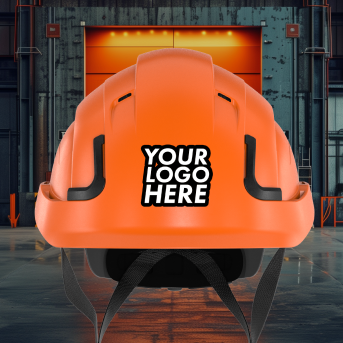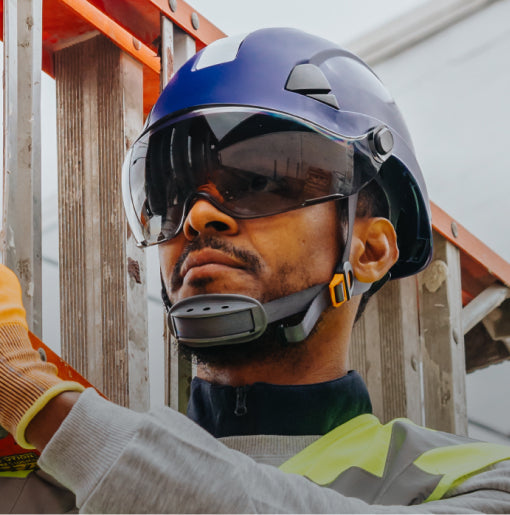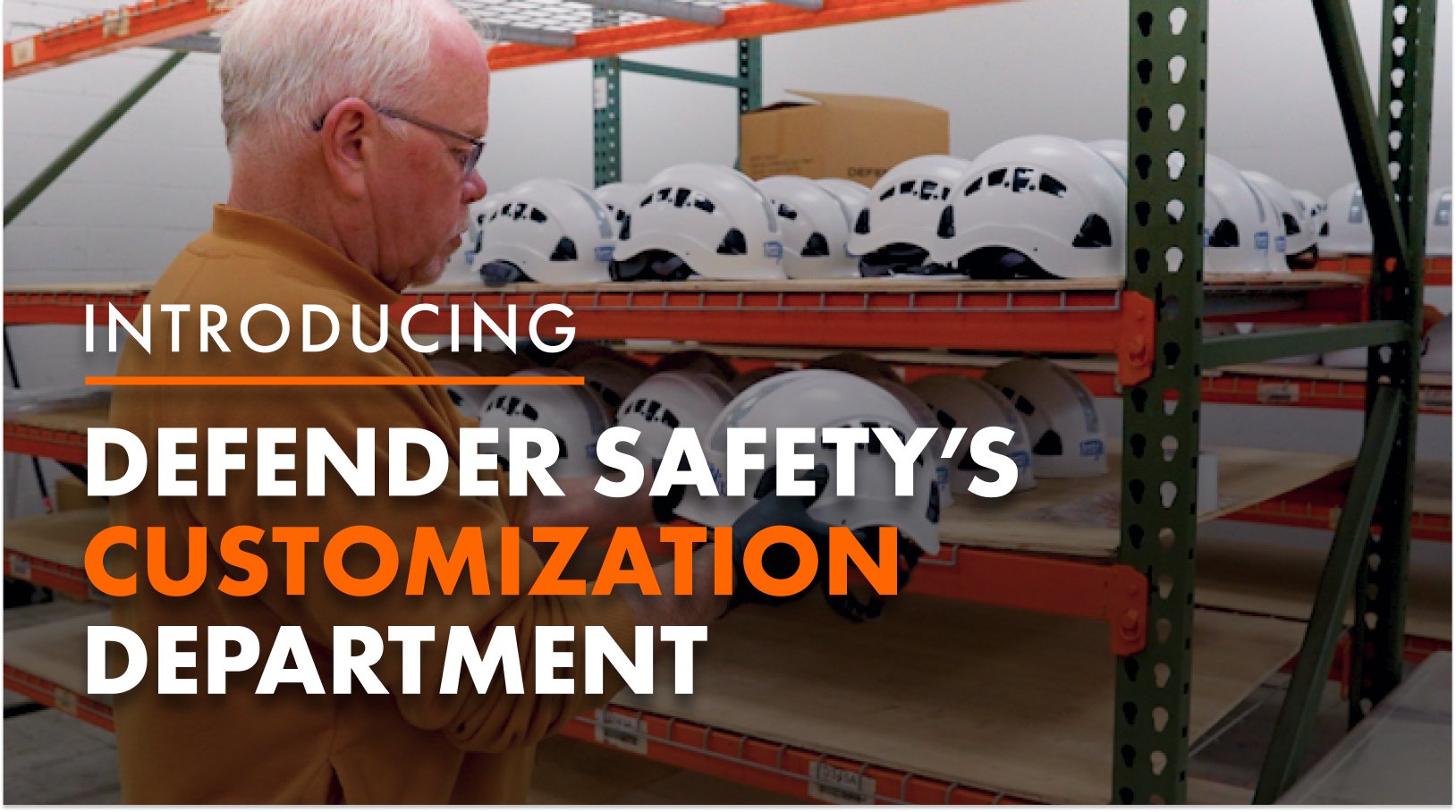As of 2023, ANSI Z89 is the main standard for industrial head protection, specifically for the US market. The American National Standards Institute (ANSI) developed this standard to provide requirements for hard hats used in construction, mining, and other industrial settings. The standard classifies two types of helmet: Type 1 and Type 2.
Type 1 hard hats are designed to protect workers from impacts to the top of the head and from objects that may fall from above and Type 2 provides additional side protection. They are the most commonly used hard hats in the construction industry and are required by Occupational Safety and Health Administration (OSHA) regulations for most construction work.
Other safety standards are also popular in the construction industry such as OSHA’s 29 CFR 1926. However, a new standard is gaining popularity in the US which is the EN 12492. The question becomes, will this become the new standard for workers safety? In this blog we will deep dive to truly understand what the EN 12492 is, what the difference is with ANSI, and if it’s a standard that’s right for your job-site needs.
What Is EN-12492?
EN 12492 is a European standard that specifies requirements and test methods for mountaineering helmets. The standard was developed to ensure that mountaineering helmets provide adequate protection to climbers and mountaineers who are exposed to the risk of head injury from falling objects, impacts with hard surfaces, or other hazards.
The EN 12492 standard defines the requirements for the design, construction, materials, and performance of mountaineering helmets. It also specifies the testing methods and procedures that manufacturers must follow to ensure that their helmets meet the requirements of the standard.
To comply with EN 12492, mountaineering helmets must provide protection against penetration, shock absorption, and retention system strength. They must also be designed to provide adequate ventilation and be comfortable to wear for extended periods of time.
If a mountaineering helmet meets the requirements of EN 12492, it will be marked with the CE mark and the relevant EN standard number. This indicates that the helmet has been tested and certified to meet the safety standards set by the European Union.
What Is ANSI Z89?
ANSI Z89 is a standard developed by the American National Standards Institute (ANSI) that specifies requirements for industrial head protection, including hard hats used in construction, mining, and other industrial settings. The standard is officially known as "ANSI/ISEA Z89.1-2014 (R2019): American National Standard for Industrial Head Protection."
The ANSI Z89 standard sets requirements for the design, performance, testing, and certification of industrial head protection, including hard hats. The standard defines two types of hard hats:
- Type I hard hats are designed to provide impact protection from blows to the top of the head, as well as protection from lateral impacts and penetration from objects that may fall from above.
- Type II hard hats provide the same level of protection as Type I, but also provide additional protection against lateral impacts from the front, sides, and rear.
The standard specifies the performance criteria that hard hats must meet, including impact resistance, penetration resistance, electrical insulation, and resistance to flame and heat. Hard hats must be tested and certified to meet the requirements of the ANSI Z89 standard before they can be sold and used in the workplace.
What Is The Difference Between ANSI Z89 And EN-12492?

ANSI Z89 and EN 12492 are two different standards that set requirements for helmets used for different purposes.
ANSI Z89 is a standard developed by the American National Standards Institute that specifies requirements for industrial head protection, including hard hats used in construction, mining, and other industrial settings. The standard defines the performance criteria for helmets, including impact resistance, penetration resistance, and electrical insulation.
EN 12492, on the other hand, is a European standard that specifies requirements and test methods for mountaineering helmets. The standard is intended to ensure that mountaineering helmets provide adequate protection against hazards such as falling objects, impacts with hard surfaces, and other hazards.
While both standards set requirements for helmets, there are some key differences between them. For example, ANSI Z89 requires helmets to provide protection against electrical hazards, while EN 12492 does not. EN 12492, on the other hand, requires helmets to provide adequate ventilation to prevent overheating during physical activity, while ANSI Z89 does not have a specific requirement for ventilation.
In summary, ANSI Z89 and EN 12492 are two different standards that set requirements for helmets used in different industries and for different purposes.
ANSI Z89 is for industrial head protection, while EN 12492 is for mountaineering helmets. The two standards have some similarities in terms of impact and penetration resistance, but also have some differences in other performance criteria.
Is EN-12492 Required By OSHA?
No, EN 12492 is a European standard and is not required by OSHA (Occupational Safety and Health Administration) in the United States. OSHA has its own set of regulations and standards for personal protective equipment (PPE) including helmets that are designed to protect workers from head injuries in various industries.
In the US, OSHA's requirements for head protection are outlined in 29 CFR 1910.135, which specifies the types of helmets that must be used in different workplace settings, the criteria for helmet selection, and the testing and certification requirements for helmets.
While EN 12492 is not required by OSHA, some employers in the US may choose to use helmets that meet this standard as it provides an additional level of assurance that the helmet is designed and tested to meet certain safety requirements. However, helmets that meet EN 12492 must also meet the requirements of OSHA standards in order to be used in the workplace in the United States.
Can a Helmet Meet Both ANSI Z89 And EN 12492 Standards?
It is possible for a helmet to meet both ANSI Z89 and EN 12492 standards, but it would depend on the specific design and intended use of the helmet. ANSI Z89 and EN 12492 are two different standards that set requirements for helmets used in different industries and for different purposes.
ANSI Z89 is a standard developed by the American National Standards Institute that specifies requirements for industrial head protection, including hard hats used in construction, mining, and other industrial settings. The standard defines the performance criteria for helmets, including impact resistance, penetration resistance, and electrical insulation.
EN 12492, on the other hand, is a European standard that specifies requirements and test methods for mountaineering helmets. The standard is intended to ensure that mountaineering helmets provide adequate protection against hazards such as falling objects, impacts with hard surfaces, and other hazards.
If a helmet is designed to be used in both industrial and mountaineering settings, it would need to meet the requirements of both standards. However, meeting the requirements of one standard does not guarantee that the helmet would meet the requirements of the other standard, as the two standards have different performance criteria and testing methods.
Manufacturers may choose to design helmets that meet both standards, but this would require careful consideration of the requirements of both standards and the intended use of the helmet. In general, helmets that are designed to meet both ANSI Z89 and EN 12492 would need to provide a high level of impact and penetration resistance, as well as protection against other hazards such as electrical shock or extreme temperatures, depending on the specific requirements of the standards.
Defender Safety recently launched the H2 series safety helmets that offer both ANSI Type 2 protection and are compliant with EN 12492 standard. It comes in 7 different colors and two classes: Class E and Class C. The Type C helmet has 360 degrees of ventilation, and is great when working in hot environments. The Type E helmet utilizes the patented Volfense™ technology to protect users against 20,000 Volts.
Regardless of the class, the H2 are the perfect solution for the job site, or if you are involved in any environment that requires head protection like mining, construction, and forestry.
The Defender Safety H2 Safety Helmets are OSHA compliant and exceeds all the ANSI Z89 and EN 12492 testing requirements so your workers can feel safe and confident at the task at hand.
Interested in learning more about the product? Click the “Shop now” button below!

 ANSI Z89 and EN 12492 are two different standards that set requirements for helmets used for different purposes.
ANSI Z89 is a standard developed by the American National Standards Institute that specifies requirements for industrial head protection, including hard hats used in construction, mining, and other industrial settings. The standard defines the performance criteria for helmets, including impact resistance, penetration resistance, and electrical insulation.
EN 12492, on the other hand, is a European standard that specifies requirements and test methods for mountaineering helmets. The standard is intended to ensure that mountaineering helmets provide adequate protection against hazards such as falling objects, impacts with hard surfaces, and other hazards.
While both standards set requirements for helmets, there are some key differences between them. For example, ANSI Z89 requires helmets to provide protection against electrical hazards, while EN 12492 does not. EN 12492, on the other hand, requires helmets to provide adequate ventilation to prevent overheating during physical activity, while ANSI Z89 does not have a specific requirement for ventilation.
In summary, ANSI Z89 and EN 12492 are two different standards that set requirements for helmets used in different industries and for different purposes.
ANSI Z89 is for industrial head protection, while EN 12492 is for mountaineering helmets. The two standards have some similarities in terms of impact and penetration resistance, but also have some differences in other performance criteria.
ANSI Z89 and EN 12492 are two different standards that set requirements for helmets used for different purposes.
ANSI Z89 is a standard developed by the American National Standards Institute that specifies requirements for industrial head protection, including hard hats used in construction, mining, and other industrial settings. The standard defines the performance criteria for helmets, including impact resistance, penetration resistance, and electrical insulation.
EN 12492, on the other hand, is a European standard that specifies requirements and test methods for mountaineering helmets. The standard is intended to ensure that mountaineering helmets provide adequate protection against hazards such as falling objects, impacts with hard surfaces, and other hazards.
While both standards set requirements for helmets, there are some key differences between them. For example, ANSI Z89 requires helmets to provide protection against electrical hazards, while EN 12492 does not. EN 12492, on the other hand, requires helmets to provide adequate ventilation to prevent overheating during physical activity, while ANSI Z89 does not have a specific requirement for ventilation.
In summary, ANSI Z89 and EN 12492 are two different standards that set requirements for helmets used in different industries and for different purposes.
ANSI Z89 is for industrial head protection, while EN 12492 is for mountaineering helmets. The two standards have some similarities in terms of impact and penetration resistance, but also have some differences in other performance criteria.











